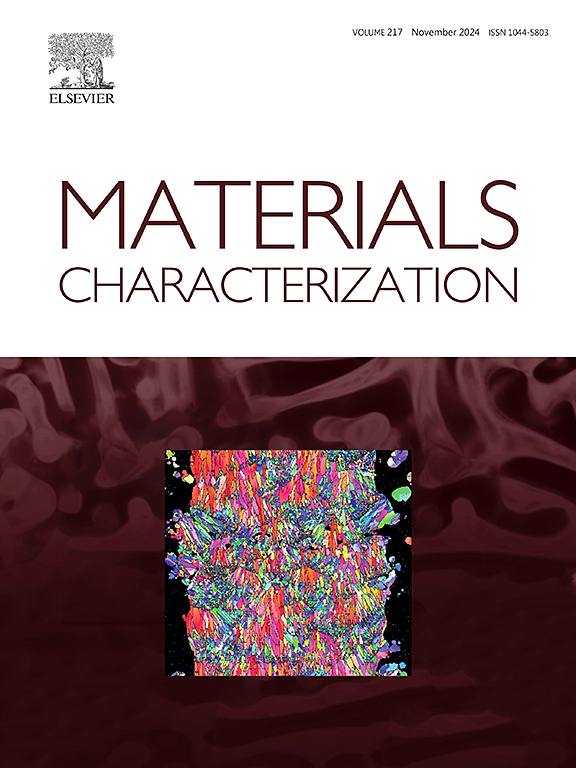Synergistically engineered Ti-based interlayer for high-strength pulsed-current diffusion bonding of TiAl/Ti2AlNb joints at ambient and elevated temperatures
IF 4.8
2区 材料科学
Q1 MATERIALS SCIENCE, CHARACTERIZATION & TESTING
引用次数: 0
Abstract
Reliable joining of TiAl and Ti2AlNb alloys, pivotal for high-temperature aerospace applications, remains challenging due to their structural and chemical disparities, which often result in brittle interfacial phases and degraded mechanical performance. This study introduces a synergistically engineered Ti-based interlayer for pulsed-current diffusion bonding (PCDB), enabling high-strength joints with exceptional stability across ambient and elevated temperatures. The interlayer, featuring a metastable β matrix and multi-element solid solution, which promotes the formation of a gradient interfacial structure: a dual-phase α2 + B2 layer and a single phase α2 layer on the TiAl side, and a B2-dominant structure on the Ti2AlNb side. Optimal bonding at 900 °C yields uniform diffusion layers, balancing elemental interdiffusion and microstructural stability to achieve peak tensile strengths of 684.1 MPa at room temperature (fracturing in the TiAl substrate) and 587.9 MPa at 700 °C—surpassing conventional interlayer-based joints. Strengthening arises from synergies between solid-solution, intracrystalline defects (dislocation walls and nanotwins), and gradient interfacial structures, demonstrating a breakthrough in joining dissimilar Ti![]() Al intermetallics for high-performance engineering applications.
Al intermetallics for high-performance engineering applications.

协同设计ti基中间层,用于室温和高温下TiAl/Ti2AlNb接头的高强度脉冲电流扩散连接
TiAl和Ti2AlNb合金是高温航空航天应用的关键,由于它们的结构和化学差异,通常会导致界面相脆性和机械性能下降,因此可靠的连接仍然具有挑战性。该研究引入了一种协同设计的ti基夹层,用于脉冲电流扩散键合(PCDB),使高强度接头在环境和高温下都具有出色的稳定性。中间层以亚稳的β基体和多元素固溶体为特征,形成了梯度界面结构:TiAl侧为双相α2 + B2层和单相α2层,Ti2AlNb侧为B2主导结构。900°C时的最佳结合可以产生均匀的扩散层,平衡元素间扩散和微观组织稳定性,在室温下达到684.1 MPa (TiAl衬底破裂),在700°C时达到587.9 MPa -超过传统的层间连接。强化是由固溶、晶内缺陷(位错壁和纳米孪晶)和梯度界面结构之间的协同作用产生的,表明了在高性能工程应用中连接不同TiAl金属间化合物的突破。
本文章由计算机程序翻译,如有差异,请以英文原文为准。
求助全文
约1分钟内获得全文
求助全文
来源期刊

Materials Characterization
工程技术-材料科学:表征与测试
CiteScore
7.60
自引率
8.50%
发文量
746
审稿时长
36 days
期刊介绍:
Materials Characterization features original articles and state-of-the-art reviews on theoretical and practical aspects of the structure and behaviour of materials.
The Journal focuses on all characterization techniques, including all forms of microscopy (light, electron, acoustic, etc.,) and analysis (especially microanalysis and surface analytical techniques). Developments in both this wide range of techniques and their application to the quantification of the microstructure of materials are essential facets of the Journal.
The Journal provides the Materials Scientist/Engineer with up-to-date information on many types of materials with an underlying theme of explaining the behavior of materials using novel approaches. Materials covered by the journal include:
Metals & Alloys
Ceramics
Nanomaterials
Biomedical materials
Optical materials
Composites
Natural Materials.
 求助内容:
求助内容: 应助结果提醒方式:
应助结果提醒方式:


